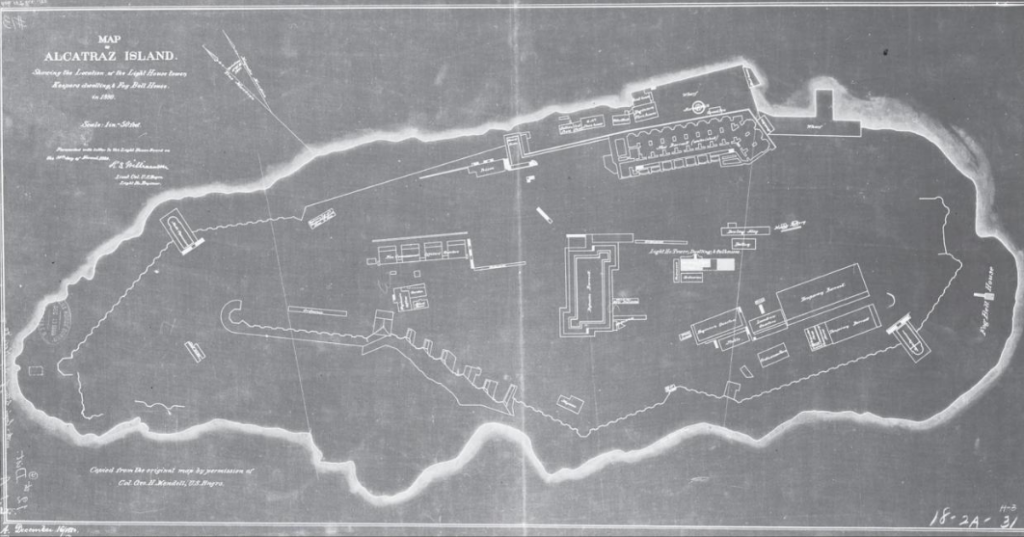Sometimes, it’s the place that dictates the story. To diehard spirit-seekers, Alcatraz ranks at the top of the list of the world’s most haunted prisons. From the coin-operated tower viewers at Fisherman’s Wharf to Ghirardelli Square, Alcatraz looks calm, inviting even. But when you get up-close and personal with the history of Alcatraz, a different story emerges.
Alcatraz: From a Military Garrison to a Legendary Prison

Although the most legendary Alcatraz jailbirds occupied the island between 1934 and 1963 — including “Scarface” gangster Al Capone and murderer Robert Stroud, the “Birdman of Alcatraz” — its story began much earlier. In 1775, a Spanish explorer named the rugged island La Isla de los Alcatraces, or Island of the Pelicans. Three quarters of a century later, President Millard Fillmore transferred the island to the American military, and it became home to the first operational lighthouse on the West Coast.
Due to its fortress-like appeal, Alcatraz quickly became regarded as a secure location to store cannons, military ammunition, and dangerous criminals. As early as 1861, the military used Alcatraz Island to house prisoners of war from the Civil War. By 1906, San Francisco and the state of California used the island to lock away civilian prisoners, but it didn’t become the Alcatraz Federal Penitentiary until it was acquired by the United States Department of Justice in 1933.
During its 29 years in use, Alcatraz held some of the most notorious American criminals, including Capone, Stroud, George “Machine Gun” Kelly, and Bumpy Johnson. Even though the prison sits on an old military fortress surrounded by ice-cold water, several prisoners attempted to escape Alcatraz with no luck.
The notoriously successful escapees Frank Morris, John Anglin, and Clarence Anglin managed to break out of the impenetrable prison, but they were never seen again. It is believed that they drowned in the rough waters surrounding the San Francisco Bay.
The Legendary Ghosts Still Behind Bars
With all of these harrowing tales and fascinating legends, the island is popular with ghost-hunters, who look to connect with some of the most infamous departed souls on The Rock. Learn more about these ghosts in Ghosts and Legends of Alcatraz.
- The Ghost Woman of Alcatraz — In 2014, a British couple on a tour of the island captured a photo of a ghostly woman whom they dubbed The Ghost Woman of Alcatraz. The couple claims they had no intention of capturing photos of spirits during their trip, and only noticed the woman — who appears to be staring knowingly directly into the camera’s lens — after they snapped the shot.
- Warden James Johnston — The first warden of Alcatraz, James A. Johnson, reportedly heard and saw many strange sounds and sights during his time patrolling the prison, indicating that the ghosts that still linger in the blocks may be from its time as a military prison or even before. Johnson reportedly heard a woman sobbing while conducting a tour of the prison in its heyday.
- Native American Ghosts — Some ghost-hunters and spirit-seekers believe that they have interacted with ghosts from Alcatraz’s earliest days. In fact, some believe that Native American prisoners who perished during the Civil War still haunt the prison, reporting whispering and moaning sounds at night and claiming to see floating blue lights and figures. Some even report hearing the clanking of prison chains.
- Al Capone’s Banjo — Legend has it that Al Capone spent many of his last days at Alcatraz strumming his guitar in the shower room; the guards granted him permission to play there rather than put himself at risk in the prison yard. Now, some visitors of the prison report hearing the sounds of a far-off banjo strumming throughout the prison.
- Cell 14-D — Paranormal-seekers believe that the D-Block section of Alcatraz is the most haunted. It includes cell 14-D, which served as “The Hole,” a place of punishment for particularly difficult prisoners. Visitors report that cell 14-D is always freezing cold, even during the summer, and that it elicits a feeling of sudden intensity. People also believe ghosts linger in cells 11, 12, and 13 of D-Block.

